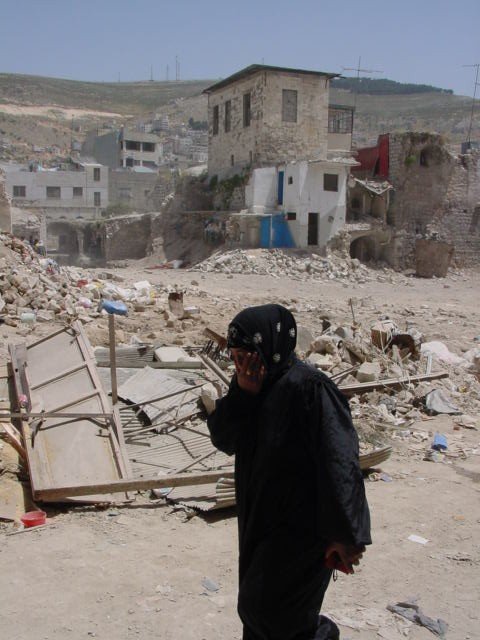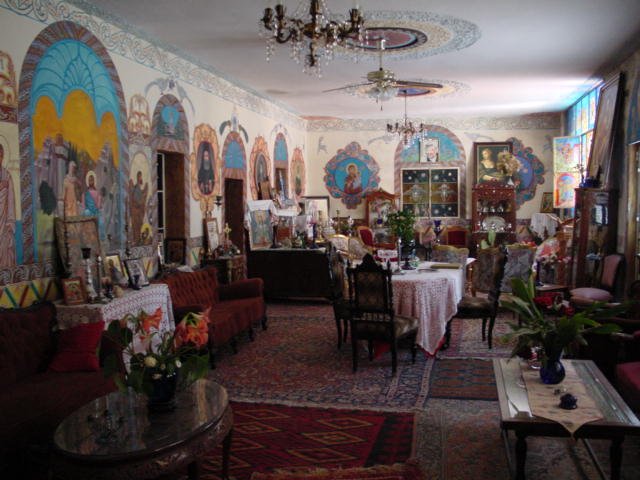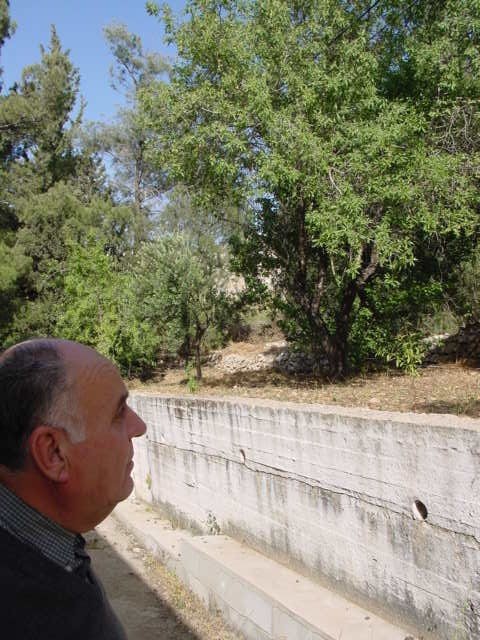May 11, 2002
Walking through the destruction of Nablus’ Old City.
One of our good friends in Nablus is a Dutch nurse who spent the entire time of the incursion at the Anglican Hospital. We would get updates from her about the situation in Nablus, since she has an antiquated "Cellcom" cellphone (Palestinian service was completely knocked out for weeks). She and Marthame went through the Old City to see more of the damage - the comment was often how much better things look now (hard to imagine). People are trying to get on with their lives, their businesses. Perhaps that's the sign of hope.
Scenes of the destruction in Nablus.
People waiting to enter the Jordanian field hospital set up outside of Nablus.
The Jordanian field hospital at work in Nablus.
They wandered down towards the Jordanian hospital, set up more or less like a MASH unit, providing free services for the people of Nablus - everything from a pharmacy to surgery is available. They have been serving about 1700 people each day, something that is clearly needed these days. It does raise the question of long-term solutions, though, seeing that there are several hospitals in Nablus upon whom doctors and nurses depend for their livelihood, and which may have to close their doors from lack of business. In a crisis like this, temporary emergency help is welcomed, but we hope it won't come at the cost of the local infrastructure. The director of the hospital gave Marthame a poster of King Abdallah to take home.
A basilica is being built above Jacob’s Well in Nablus.
Marthame and our friend then headed down to Jacob's Well, the site of Jesus' conversation with the Samaritan woman about "living water" (John 4). Father Justinus, the Greek Orthodox priest/caretaker, has been in his position here for 20+ years. He was sent to build a cathedral, and work is progressing impressively. For the first 16 years, though, it didn't - the Israeli military government didn't give out many building permits (required to build new buildings to repair and expand existing ones), so Abuna Justinus (who is quite the artist) spent them decorating the inside of the convent with beautiful mosaics and icons. One picture is of one of the previous caretakers, who was killed in 1979 by a radical rabbi and his followers who wanted to take the Well over. The work (all by hand) is continuing - hopefully it will be finished soon.
Marthame then headed up with Fr. Hossam to the Christian neighborhood of Raffidya to have lunch and to visit with his fiancee, the first time that either of us have seen her since their engagement in August. Their wedding will be this summer, so they're busy making plans. (Since his family is in the Galilee and hers is in Nablus, they are faced with the problem of location. His family, Israeli citizens, are not allowed into the West Bank; she and her family are Palestinians not allowed into Israel. It looks like they will have to foot the expense of getting all their family to Jordan in order to get married.)
Marthame then stopped by to see the dear and gentle Abuna Yousef, Melkite priest of St. John the Baptist church. Unlike his usual manner, though, he was clearly agitated by the situation - not so much by what had happened in Nablus, but more by the siege of the Nativity Church. He observed that Sharon made his controversial visit to Al-Aqsa, to which the whole Muslim world reacted strongly. Meanwhile, the Church was surrounded by tanks for forty days, eight people (including a bell-ringer, priest, and a couple of people hanging up laundry) were shot, seven of them fatally. The response? In his words, the Pope's envoy asked Sharon for permission to visit the Church, was told no, and accepted this word. His faith in the soldarity of the wider church with the Christians of this land has waned greatly - but his faith in Christ is strong.
He also shared his plans for a Christian cultural center and housing complex to be built on the grounds of the Melkite Convent - something to help stem the tide of Christian emigration. The need is for funding. We hope he can find it.
Just a sampling of Fr. Justinus’ handiwork on display at Jacob’s Well.
After visiting with a friend of ours studying at An-Najah University, and eating Nablus' specialty dessert of knaffe, Marthame headed back to the Anglican Compound to join in with the family's nightly ritual of dinner and late night movies from Jordan (featuring the 1968 Peter Ustinov comedic vehicle Blackbeard's Ghost - "surreal" only scratches the surface of this place). The family (a grandmother, her two sons, daughter-in-law, and two grandsons) shared their stories of what it was like to be here during the military activity. Sixteen days without leaving home with little (and then no) water and no electricity. For a stretch of five days, they were stuck in one room (the only one without windows), unable to stand up beyond a crawl, as glass shattered in the other rooms and the constant sound of tank and machine gunfire echoed, punctuated by the periodic horrific rush of an F-16 bomb. This is the frustration Palestinians share in common - many people, regardless of political or military involvement, suffer similarly. the "terrorist infrastructure". Hard to imagine.
Fr. Yousef, the Melkite priest of Nablus, looking over the land.
One of the sons spent most of those five days entertaining the two grandsons, doing shadow puppets on the wall. At one point, they devised a shirt for use at checkpoints - by tying strings from the sleeves to the bottom of the shirt, you could raise your arms and your shirt in one movement (something many young Palestinian men have been forced to do in the last several months). They jokingly made plans to market their new invention. Such is humor these days...







